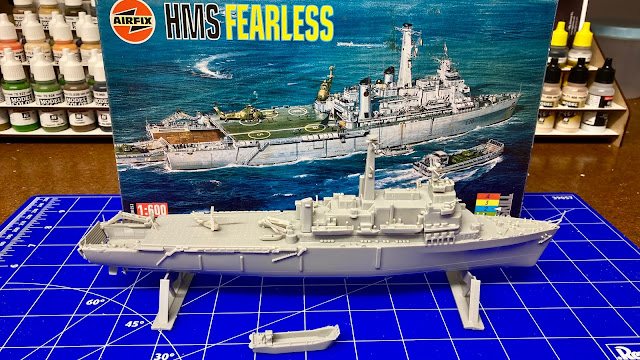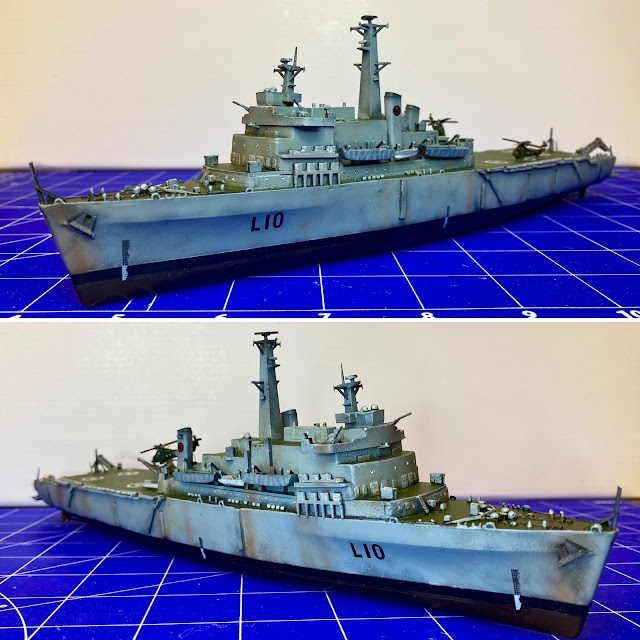HMS Fearless (L10) was the first of two purpose-built LPD (landing platform docks) commissioning in 1965, the second being HMS Intrepid (L11) commissioned in 1967. The LPD were designed to be used by the Royal Navy to support a Royal Marines amphibious assault force (700 troops, 15 tanks, 27 vehicles and 5 helicopters) and provide a platform for Brigade Headquarters prior to, and during, the assault phase.
As a result of defence cuts, HMS Intrepid went into reserve in 1976, being brought back into active service in 1979 to allow HMS Fearless to be refitted. Following the announcement in 1981 that both LPDs were to be decommissioned, HMS Intrepid, then already undergoing decommissioning, was rapidly brought back into commission in 1982, to join HMS Fearless, as part of the British Task Force committed to Operation Corporate, to recapture the Falkland Islands.
The Task Force comprised 3 operational entities:
- Battle Group led by the aircraft carriers HMS Hermes and HMS Invincible under Admiral Sandy Woodward with responsibility for securing air and sea superiority
- Paraquet Group sent ahead of the Battle Group under Captain Brian Young Antrim, to launch Operation Paraquet, the retaking of South Georgia
- Amphibious Group, which followed some weeks after the Battle Group, led by HMS Fearless and HMS Intrepid under Commodore Mike Clapp, would lead the amphibious landings at San Carlos Water.
HMS Fearless, the HQ for the staff of amphibious force, sailed from Portsmouth at 1000 on 6th April to join the Battle Group, who left and arrived a day earlier, at Ascension Island on 17th April. While the Battle Group continued on to the Falklands the following day, HMS Intrepid joined HMS Fearless on 20th April. Both then left Ascension with the Amarda of navy and troop carrying merchant ships, which made up the Amphibious Group, on 7th May. This split in the Task Force was by design, Sandy Woodward wanted to ensure his Battle Group was free to remove as much of the Argentine threat of submarine, ship and air attack, without having to worry about protecting or risking the loss of any of the Amphibious Group at the same time.
In the early hours of 19th May, 1,500 troops were moved from P&P’s liner Canberra, the largest requisitioned troop ship of the Amphibious Group, to the two LPDs. Once each were packed with around six hundred and fifty Royal Marines, at 0145 on the morning of 21 May, 40 Commando, together with a FV101 Scorpion and a FV107 Scimitar tank, were loaded into landing crafts - four of which were small ones to be lowered over the side, four were larger LCUs to be floated out of the ships’ stern docks once they were flooded down, and headed down San Carlos Water. Meanwhile HMS Intrepid’s LCUs made their way to SS Norland, the P&O roll-on roll-off Ferry, to pick up Colonel H Jone’s 2 Para. At 0730 40 Commando were wading through the shallows from Fearless’s landing craft and onto San Carlos beech. The landing of both HMS Fearless and HMS Intrepid’s troops was unopposed but Argentina’s response was swift. By the end of the first day, its aircraft had inflicted significant damage to British warships, the worst being to HMS Ardent. Devastated by bombing, with several major fires, she was abandoned and sank. Her crew transferred to Canberra, The end came on 14 June 1982 with the successful recapture of Port Stanley, and the Argentinian surrender.
Other key events in HMS Fearless’s service before the Falklands War
- Command platform for British Counter-Terrorism operations in Aden in 1967-1968
- The venue for talks between Harold Wilson and Ian Smith in 1968, over the future of Rhodesia.
- Ferried several Centurion AVRE demolition vehicles, derived from the Centurion tank, to Northern Ireland to be deployed as part of Operation Motorman in July 1972,
- Featured in the 1977 James Bond film The Spy Who Loved Me as the ship that picks up Bond's escape pod.
HMS Fearless was placed out of commission for three years in 1985 prior to a two-year refit at Devonport and recommissioned in 1991. Meanwhile HMS Intrepid was placed in reserve status and being in such poor physical condition by this time, was used as a source of spares for HMS Fearless. HMS Intrepid was decommissioned in 1999 with HMS Fearless following in 2002. HMS Fearless completed 35 years service with the Royal Navy, the pinnacle of which must have been her 3 month involvement in Operation Corporate, and her key role in the recapture of the Falklands Islands.
----
The model
I made and treasured this Airfix model of HMS Fearless for many years back in the 80s and so it was great to rediscover probably even the same aged kit that I made back then.
Purchased second hand, missing its helicopters and 3 of its 4 landing craft it was still a nice trip down memory lane. I managed to source a set of Wessex helicopters and positioned 2 on Fearless’s deck in the same configuration as on Airfix’s box art; with one over position 4, covering its numbered transfer which self destructed, and one airborne, probably with filled with SAS troops en route to their next mission. The single landing craft I attached leaving the ship’s stern dock, camouflaged in white tiger stripes as applied for the Falklands landings, with the addition of 2, naive scratch built, Scorpion and Scimitar tanks, which were first to land with 40 Commando on D-Day, 21 May 1982.
---
Brand: Airfix
Title: HMS Fearless
Number: 03205
Scale: 1:600
Released: 1968 - 2005 | Rebox (Changed box only)












No comments:
Post a Comment
Note: only a member of this blog may post a comment.